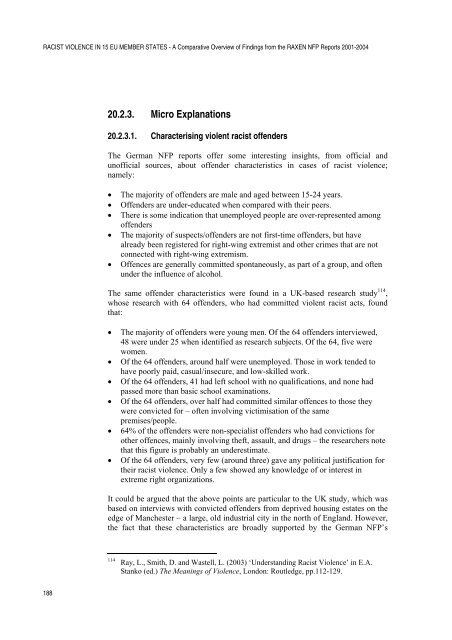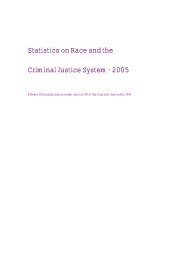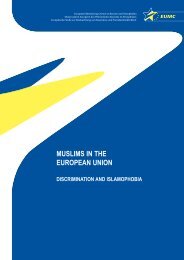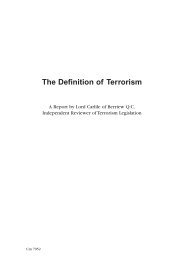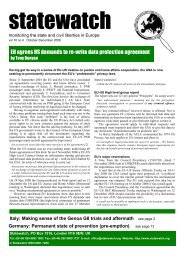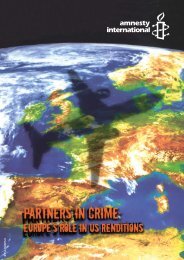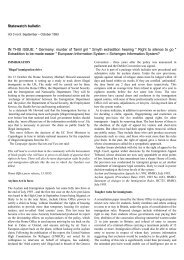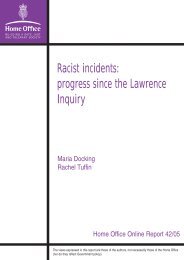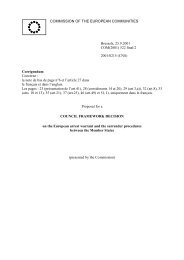RACIST VIOLENCE IN 15 EU MEMBER STATES - Cospe
RACIST VIOLENCE IN 15 EU MEMBER STATES - Cospe
RACIST VIOLENCE IN 15 EU MEMBER STATES - Cospe
You also want an ePaper? Increase the reach of your titles
YUMPU automatically turns print PDFs into web optimized ePapers that Google loves.
<strong>RACIST</strong> <strong>VIOLENCE</strong> <strong>IN</strong> <strong>15</strong> <strong>EU</strong> <strong>MEMBER</strong> <strong>STATES</strong> - A Comparative Overview of Findings from the RAXEN NFP Reports 2001-2004<br />
20.2.3. Micro Explanations<br />
20.2.3.1. Characterising violent racist offenders<br />
The German NFP reports offer some interesting insights, from official and<br />
unofficial sources, about offender characteristics in cases of racist violence;<br />
namely:<br />
• The majority of offenders are male and aged between <strong>15</strong>-24 years.<br />
• Offenders are under-educated when compared with their peers.<br />
• There is some indication that unemployed people are over-represented among<br />
offenders<br />
• The majority of suspects/offenders are not first-time offenders, but have<br />
already been registered for right-wing extremist and other crimes that are not<br />
connected with right-wing extremism.<br />
• Offences are generally committed spontaneously, as part of a group, and often<br />
under the influence of alcohol.<br />
The same offender characteristics were found in a UK-based research study 114 ,<br />
whose research with 64 offenders, who had committed violent racist acts, found<br />
that:<br />
• The majority of offenders were young men. Of the 64 offenders interviewed,<br />
48 were under 25 when identified as research subjects. Of the 64, five were<br />
women.<br />
• Of the 64 offenders, around half were unemployed. Those in work tended to<br />
have poorly paid, casual/insecure, and low-skilled work.<br />
• Of the 64 offenders, 41 had left school with no qualifications, and none had<br />
passed more than basic school examinations.<br />
• Of the 64 offenders, over half had committed similar offences to those they<br />
were convicted for – often involving victimisation of the same<br />
premises/people.<br />
• 64% of the offenders were non-specialist offenders who had convictions for<br />
other offences, mainly involving theft, assault, and drugs – the researchers note<br />
that this figure is probably an underestimate.<br />
• Of the 64 offenders, very few (around three) gave any political justification for<br />
their racist violence. Only a few showed any knowledge of or interest in<br />
extreme right organizations.<br />
It could be argued that the above points are particular to the UK study, which was<br />
based on interviews with convicted offenders from deprived housing estates on the<br />
edge of Manchester – a large, old industrial city in the north of England. However,<br />
the fact that these characteristics are broadly supported by the German NFP’s<br />
114<br />
Ray, L., Smith, D. and Wastell, L. (2003) ‘Understanding Racist Violence’ in E.A.<br />
Stanko (ed.) The Meanings of Violence, London: Routledge, pp.112-129.<br />
188


